Today, we have the MOTU 828 flagship 28x32 USB3 audio interface for Mac, Windows and iOS audio for review and testing, which was released in January 2024. Even though this audio interface was released exactly one year ago, it remains the flagship device in its class (in many respects, it is still unrivaled). The MOTU 828 is the long-awaited new product of 2024 — the latest generation of audio recording interfaces from a U.S. company specializing in this field. It's great that the manufacturer isn't "resting on one's laurels" but is constantly developing and introducing new technologies.
Be careful because when you search for "MOTU 828" online, you will find the 828 mk3 Hybrid interface. This is an outdated model from 12 years ago. You can identify it by its LED peak meters on the front panel, green matrix screen, and combined USB 2.0/FireWire connection. The new MOTU 828 model significantly surpasses its predecessor in terms of appearance, parameters & specs, and sound. Before we get into the main part of our review, let's take a look at the MOTU 828 specifications to get a better understanding of all of its features.
|
Best Price on MOTU 828 Audio Interface
The MOTU 828 is a standout audio interface in its class — offering professional-grade audio, flagship features, high-end specs, vast I/O, a polished design, and excellent value. |
 Classic Package
Classic Package
|
In our opinion, the device's list of features and specifications contains everything necessary for a professional commercial studio. If your budget allows, the MOTU 828 is also ideal for personal or home studios. We recommend familiarizing yourself with all of the device's specifications on the product page of the official MOTU website.
The MOTU 828 comes in a large box that is half the size of the audio interface itself. Inside, you will find the audio interface and a high-quality, two-meter USB-C cable certified to the USB 3.2 standard. The package also includes a printed manual and power cable. However, it is easier to visit motu.com/828-start and watch the manufacturer's video, which provides detailed instructions on installing the software for Windows and Mac.

The MOTU 828's sturdy aluminum case features a milled front panel and metal handles. It has mounts for installation in a standard studio rack stand. Alternatively, you can place the interface on a table or shelf. There are no ventilation holes on the bottom, and the electronic components do not heat up, so there will be no problems in this regard. As is traditional for MOTU, the company's proprietary Amphenol combo connectors are used. All of the knobs for gain, master control, and headphones are digital encoders. The controls turn with just the right amount of resistance. The paint quality and labeling are top-notch. The front panel has conveniently located connectors for microphones and guitars, as well as a pair of headphone outputs. These outputs are fully independent and can be assigned to different signal sources or submixes via the control panel.
All MOTU 828's knobs are traditionally digital, with a fixed step of 1 dB. This is convenient because the scale is linear to the human perception of volume. Additionally, digital encoders are more durable than variable resistors, which inevitably produce output channel skew and rustling over time.

All connection ports are located on the rear panel. They are all balanced and adjustable, of course. The MAIN OUT output is assigned to a large volume knob, while the others are controlled from the panel. Any output or submix can be routed to the MAIN OUT. There are many expansion options, including RCA, SPDIF/Toslink, as well as two ADAT banks, which provide an additional 16 input and output channels. WordClock is used for integration into an existing studio setup. Separate MIDI connectors allow you to connect various equipment, such as a MIDI keyboard. There is also a pedal jack for quickly activating an input.
The table specifies the characteristics of the inputs and outputs, as well as the maximum signal levels.

As we can see, these are excellent figures, comparable to the best studio devices with ultra-low distortion. Our measurements and tests have confirmed this. We get the best parameters among all current MOTU devices. The MOTU 828es Thunderbolt/AVB interface, released in 2017, was formally the flagship of the interface line. However, the new model has input and output distortion figures of -114 dB, which is much better than the previous model's -108 dB! Clearly, progress does not stand still.
In terms of latency, the MOTU 828es Thunderbolt connection provides an impressive 1.6 ms, while the MOTU 828 USB 3.2 connection is slightly worse at 2.0 ms. All other things being equal, we find the new 828 much more appealing, and it is much easier to connect to a computer or laptop.
We didn't use the full power of the USB 3.2 connection because we didn't have any tasks that required us to record and output 30 channels at once. However, everything here is top-notch, with convenient and accurate dB and peakmeter indications for all knob positions. Finally, the screen is expensive and bright with high-resolution graphics.
In addition to the input and output peak meters, the screen can display the basic interface settings in case it is used standalone when connected via ADAT.
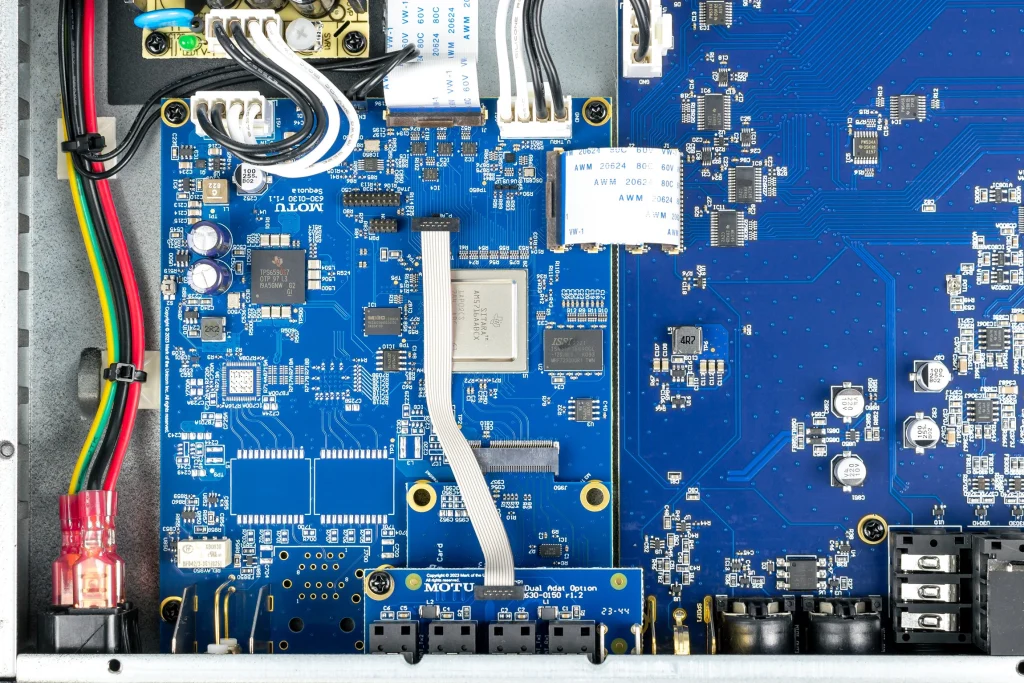
For the first time, the electronic filing features a brand new digital component. The powerful ARM Cortex-A15 TI Sitara processor supports USB 3.2, operates at high speeds, and has a built-in TI C66x hardware digital signal processor (DSP) that supports VLIW floating-point operations. This means powerful acceleration of all low-latency audio processing in a single processor operation. The two smaller chips next to it are DDR3 RAM and a power controller. Note that the digital part is located on a separate circuit board, as it should be.
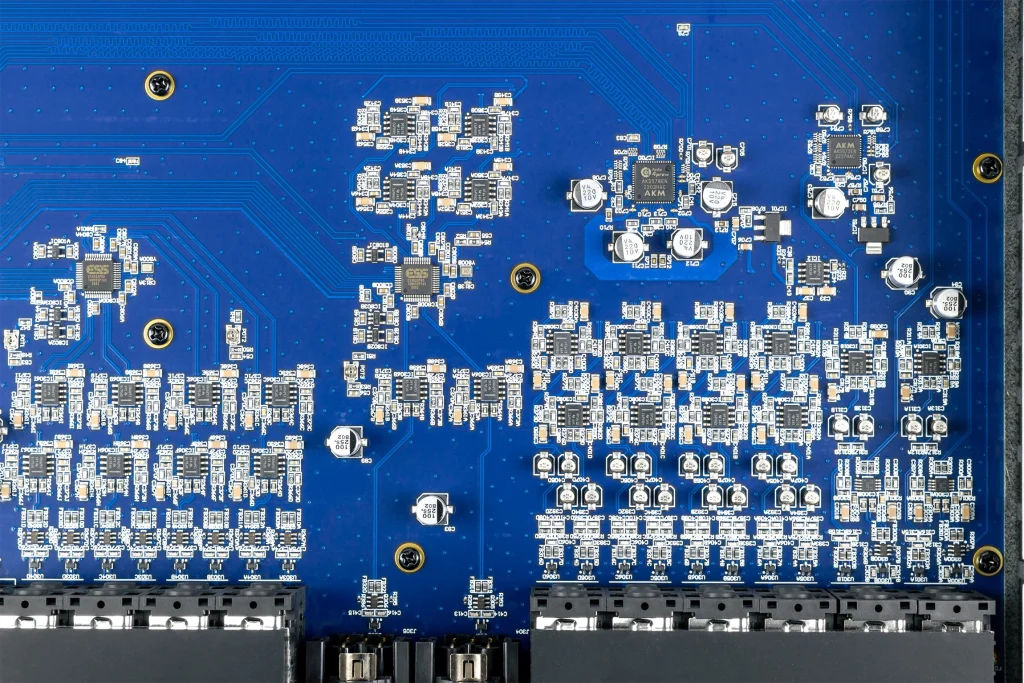
The ADC is an 8-channel, 32-bit, 768 kHz AKM AK5578 converter with a dynamic range of 121dBA and a signal-to-noise ratio of -112dB. Next to it is the two-channel version, the AKM AK5572, which has the same characteristics. Together, they provide 10 independent digitization channels.
As is typical for MOTU products, the 8-channel ES9026PRO is used as the DAC, offering a dynamic range of 124dBA and a signal-to-noise ratio of -110dB. MOTU has achieved even higher performance parameters for the final device than those stated in the chip's specifications, which speaks to the serious engineering work that went into it.
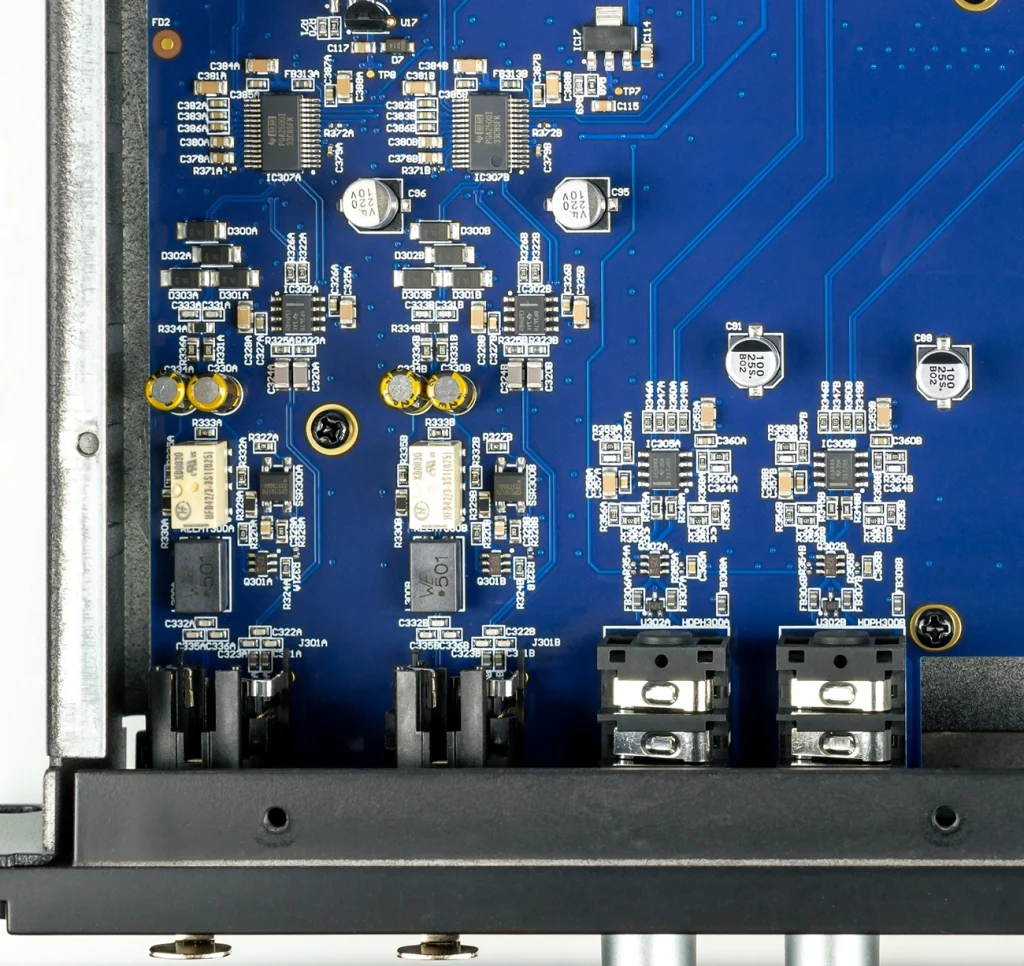
Like many of MOTU's higher-end AVB interfaces, it features the PGA2500 chip: an analog microphone preamplifier with digital input level control. The EIN noise level is -128dBu. THD+N at 30dB gain is only 0.0004%. The record gain of up to +74dB allows you to connect any low-sensitivity dynamic and ribbon microphones. The headphone output is powered by an integrated OPA1688A amplifier. The signal swing is increased from the standard 3.3 Vrms to 4 Vrms, which is sufficient for any mass-market headphone model.
The MeanWell power supply ensures compatibility with a wide range of AC networks, from 100 to 240 V, 50/60 Hz. Another advantage is the hardware power button on the front panel of the device. There is no need to search for the switch on the back of the case (rear panel).
We typically measure RTL latency using a 64-sample buffer at 44 kHz.
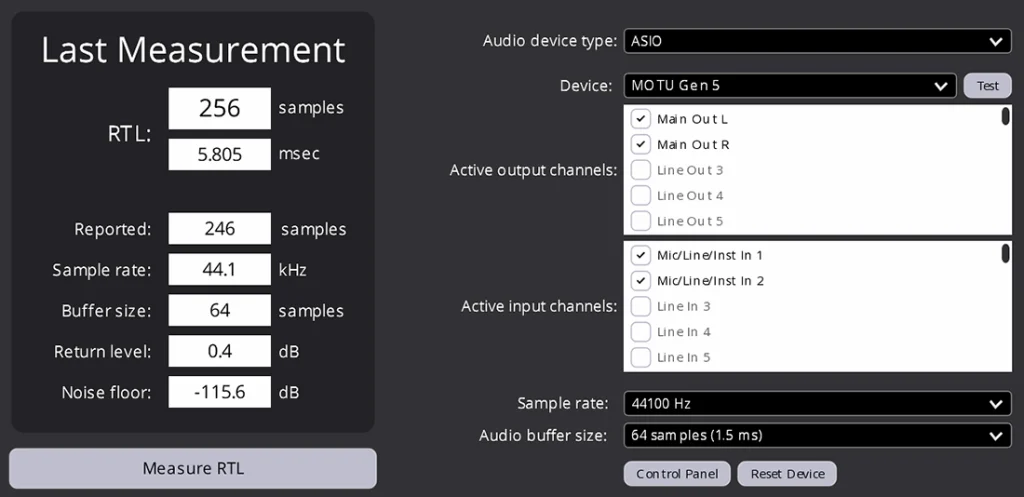
In this case, we obtained a value of 5.8 ms, which is excellent. It is one of the best values we can recall. However, the manufacturer claims 2.0 ms at 96 kHz.
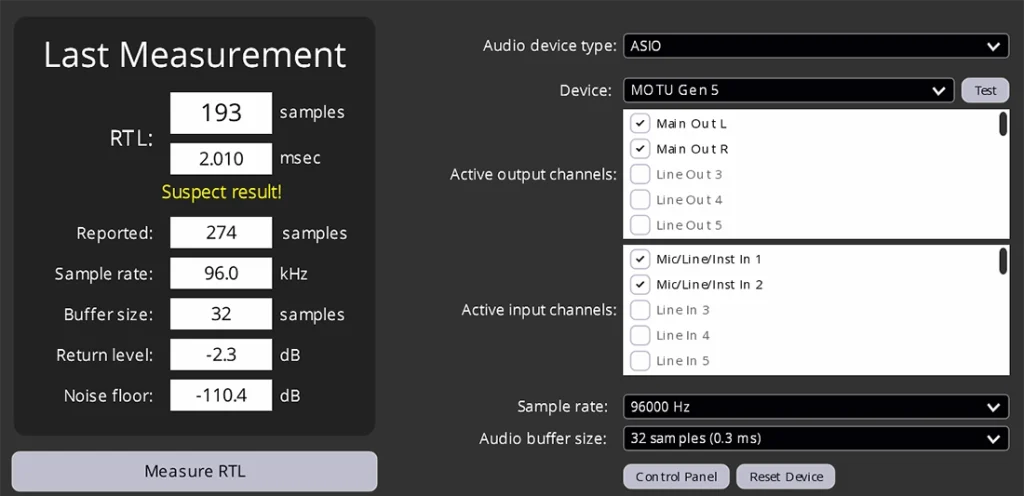
This value is indeed achieved when working in 96 kHz mode with a small ASIO buffer of 32 samples. Is it worth setting such an extreme value? Yes, if you use real-time software processing or virtual instruments. For example, this would be useful when playing a MIDI keyboard or processing a guitar sound. Keep in mind that this will require a very fast computer with a modern processor. In most cases, there is no reason to chase record-breaking latency. You can't hear the latency, and it doesn't affect the sound quality.
The MOTU 828 can be controlled from any device on the local area network (LAN), but the CueMix 5 control panel is a standalone application with a scalable interface that works well with modern high-density pixel (HiDPI) screens.
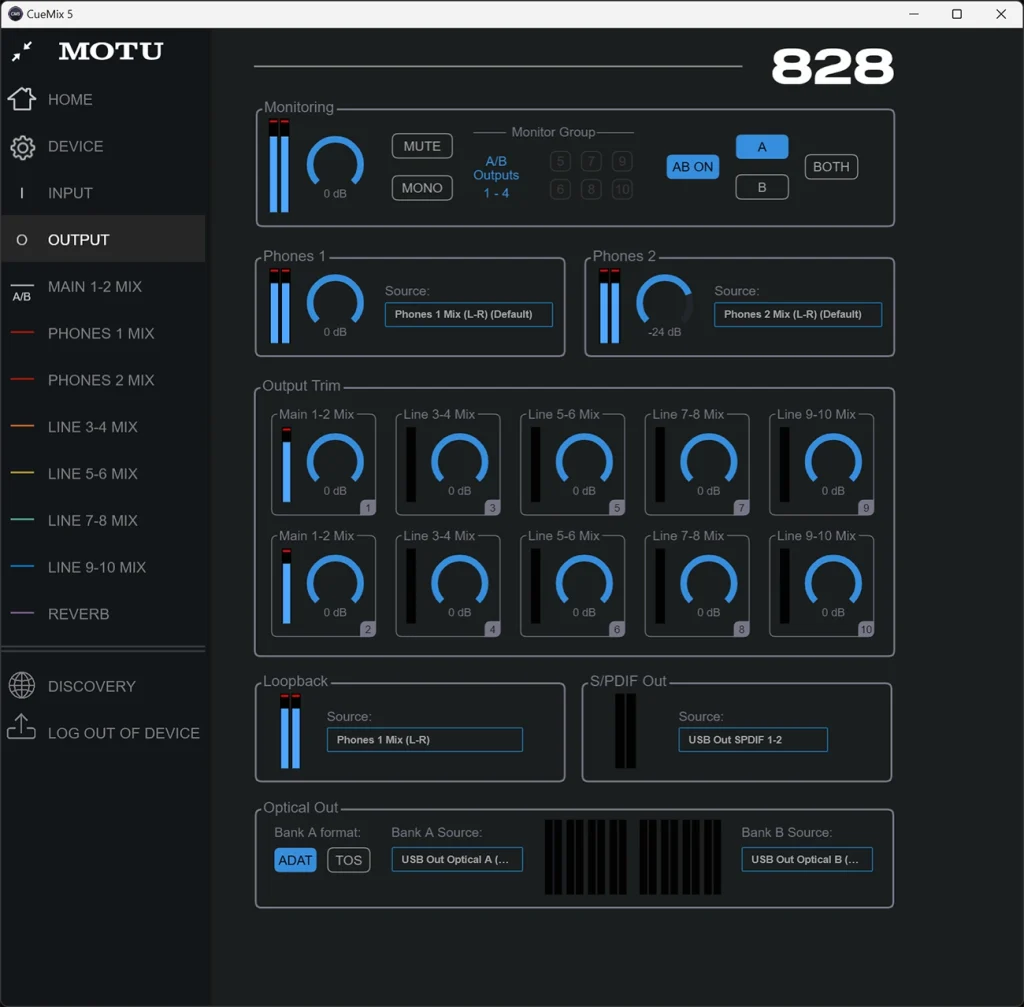
Despite its abundance of inputs and outputs, the MOTU 828 is as simple and straightforward as possible. The panel has tabs that group the peak meters and channel controls. The same peak meters are displayed on the front panel screen.
The manufacturer promptly releases firmware updates. During testing, everything worked stably without any problems with the current firmware.
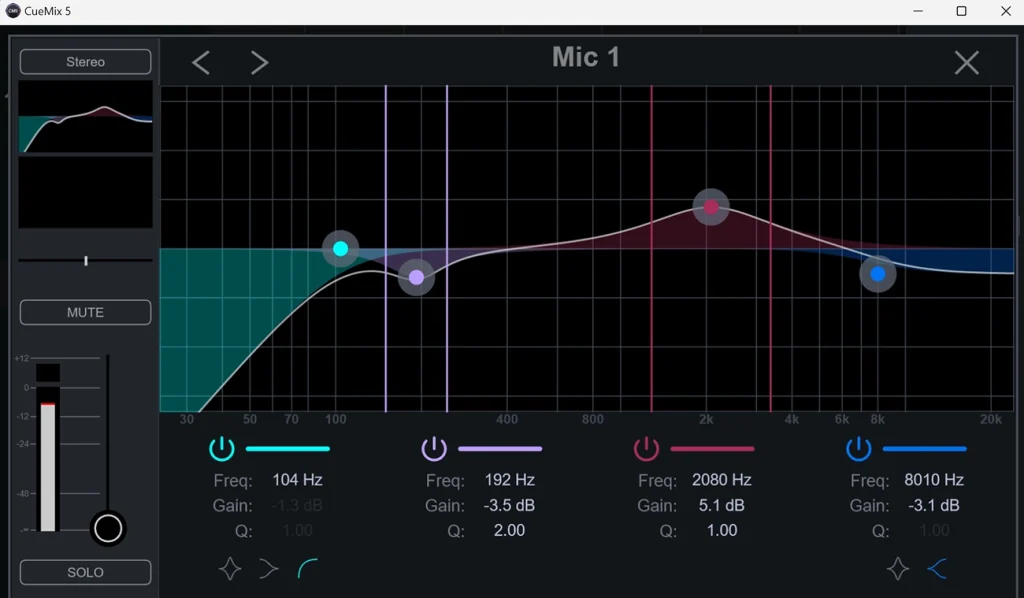
You can apply a hardware 4-band parametric equalizer to each channel. It is especially valuable that you can adjust the Q quality factor and change the filter type for the outermost bands.
The gate and compressor have standard control parameters. These are standard effects without any emulation of analog instruments. For specific real-time studio processing, a separate hardware device can be connected to the SEND and RETURN jacks on the first two channels.
The reverb is located on a separate effects bus and has the same parameters for all channels. The quality of all effects is good and applicable in real life.
We compared the MOTU 828 to our regularly used MOTU M2 (we have a separate review of this audio interface available at this link). We used a Neumann TLM103 microphone for the test voice recording. We achieved excellent professional results in both cases, though the MOTU 828 had a slight edge in transparency. In our opinion, the AKM ADC gives a warmer tone compared to the ESS ADC in the latest MOTU models. However, the difference is vanishingly small. We also prefer the MOTU 828 for sound quality from line outputs and headphones.
Finally, we've reached the end of our MOTU 828 review, it's time to summarize the results. According to the test results, we liked the MOTU 828 a lot. While the other MOTU interfaces are not inferior, it is more pleasant to work with the top model, which has the highest quality converters and ultra-low distortion. Additionally, the MOTU 828 audio interface is very simple and easy to use. We also liked its appearance and high-quality screen. The interface can replace a mixer for a live event, thanks to its hardware effects. This is especially useful considering you can control it remotely via Wi-Fi from a laptop or the CueMix iOS app. Ten analog inputs and fourteen analog outputs allow you to solve any complex studio task and scale the recording capabilities with two ADAT banks of eight channels each.
We hope you enjoyed our review of the MOTU 828 audio interface. Please feel free to leave your comments, questions, and suggestions in the section below. We will be happy to answer them all as soon as possible. If you already own MOTU 828 and have used it for a while, don't forget to share your impressions and tell us what you liked or disliked about this audio interface.
Pros
|
Cons
|
9.8
/10
Our Score
|